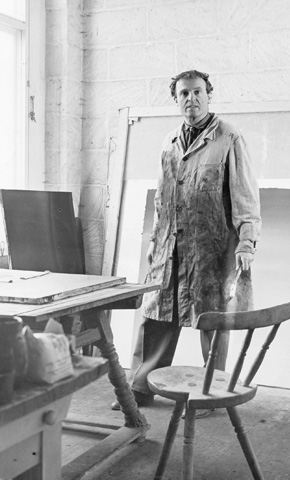|
"The realization that color is the primary element in painting should lead to its rediscovery." Since the beginning of the 1950s, Rupprecht Geiger's public reputation has been rising steadily. For his Work 'E 75', 1949 (WV 40), he would have been awarded the American Blevin Davis Prize by an international jury if he had not already passed the age limit of 40 at the time the prize was announced. This work exemplifies Geiger's creative phase at that time: a few isolated geometric and/or organic forms, some of which are modulated in themselves in terms of color, are placed on color gradients. These paintings grant the viewer glimpses into colorful spaces without local reference or perspective. Color, light-dark and cold-warm contrasts already serve here to reproduce the immanent properties of color. The characteristics specific to architecture - earthiness, materiality, heaviness - are abolished, a design principle that is used in artistic Design of the facade of the Munich main station can be seen. The mosaic-like assembled aluminum plates seem to float due to the indirect lighting. It is his first public commission in the field of art in buildings. Until the mid-sixties, he creates a few more glass paste-ups in Stockdorf, Munich and Wuppertal, in which daylight, rather than fluorescent tubes, makes the colored glass elements glow. After the much-discussed exhibition of the artist group ZEN 49 at the Central Art Collecting Point in Munich in 1950, participation in important international exhibitions followed, for example, in 1953 at the exhibition Deutsche Kunst. Masterpieces of the 20th Century in Lucerne or in 1959 at the Biennale in São Paolo and at the second documenta. Despite numerous other participations in exhibitions in Germany and abroad and his first solo exhibitions - in 1953 in the Munich gallery Otto Stangl and in the Cologne gallery Spiegel, 1956 in the Stockholm gallery Samlaren, 1957 in the Paris gallery Iris Clert - he can not yet live from his art and continues to work as an architect together with his wife Monika on various Private houses and settlements in and around Munich. However, his work was already being recognized in isolated instances. In 1951 he was awarded the prestigious Domnick Art Prize of the Staatsgalerie Stuttgart for the Work 'E 105', 1950 (WV 69). In addition to the Salomon Guggenheim Prize, New York (1959), he was awarded the Third Art Prize at the First International Triennial for Color Graphics in Grenchen, Switzerland, in 1958 for the Serigraph 'Black round to blue and green' (WVG 20) awarded. While Rupprecht Geiger experimented with (color) lithography in the late forties, he discovered serigraphy as early as 1952, which can be described as 'his' printing technique par excellence. Until the end of the fifties, he worked in parallel with both techniques, before concentrating almost exclusively on serigraphy until the end. This printing technique allows not only extremely subtle color modulations, but the creation of series in different color variations and the use of dayglow pigments. The most productive phase is the sixties. Rupprecht Geiger works with numerous publishers (galleries, art associations, museums and publishing houses) on single editions, series and portfolios. He also creates posters in screen printing, for example for Exhibitions or for the Concert series 'Musica viva. For these, whose typography is done by his son Lenz Geiger, he gets the specification from the city of Munich to make his strong color scheme a little more restrained, as it could be perceived as too disturbing in the cityscape. On the occasion of the exhibition of his entire graphic oeuvre at the Kunstverein Wolfsburg, the first 'Werkverzeichnis der Graphik 1948-1964' is published, edited by the gallery owner Rolf Schmücking. |
 In these years, he is increasingly reflecting on the simple form: "The variety of abstract forms with their often whimsical outlines distracts from the color, whereas with archetypal forms, such as rectangles and circles, the color can emerge unaffected. In order to be able to analyze the color even better, I transfer the composition principle of the counterpoint to the color and give a basic color a contrasting color as an exponent to the side." He thus limits his vocabulary of forms to elementary shapes, so that the viewer can concentrate on the perception of color. The formal reduction is combined with a strict and clear composition: On top of a modulated color field, Rupprecht Geiger applies a contrasting color (exponent/contrapunctum) to, to further increase the intensity of the modulation and its color. From the mid-fifties to the mid-sixties he works mainly in oil. Since the fifties, Rupprecht Geiger, inspired by the first space explorations, has been concerned with the experience of time and space. In 1961, the work '361/61 (Gagarin)' (WV 333) was created, whose title refers to the Soviet cosmonaut Yuri Gargarin, the first man to orbit the earth. Other work titles indicate which travel sites are visited: For example, in 1964 Rupprecht Geiger visits his son Florian in Morocco, who works in an architectural office in Casablanca, and subsequently paints 'Boumalne' (WV 395), 'Tafraoute' (WV 396) and 'Tinerhir' (WV 397), as well as 'Goulimine' (WV 368). This last painting is shown, among others, at the third documenta in Kassel in 1964. Author: Julia Geiger |
